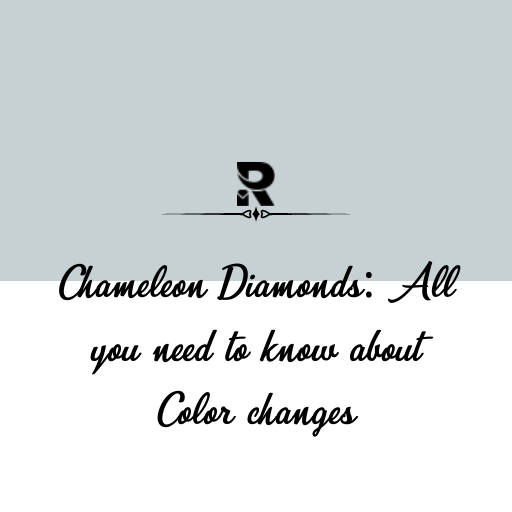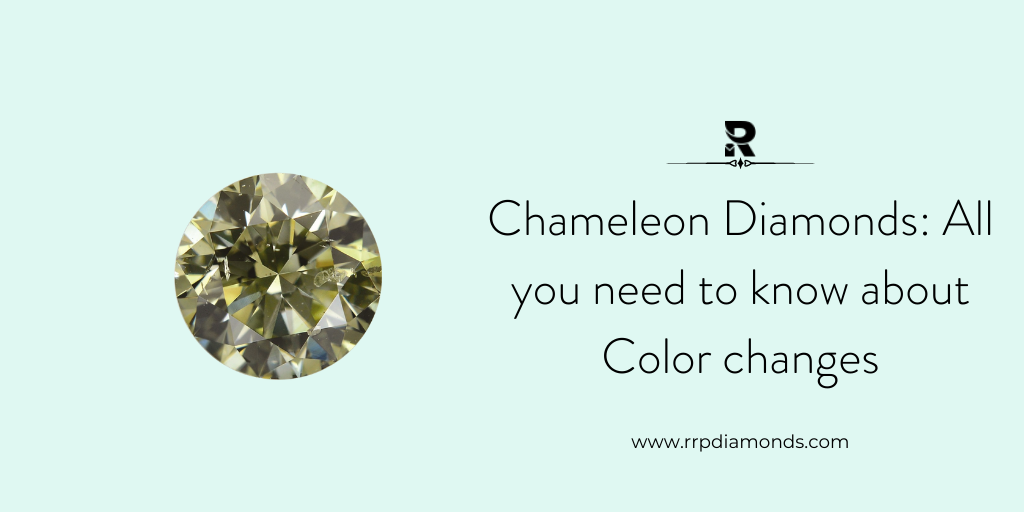
With the diamond industry being as vast and mysterious as it is, another addition to the riddle is the chameleon diamonds which are a rare and extremely intriguing category of diamonds that, as the name suggests, portray the characteristics of a chameleon.
The temporary changes in the color under conditions like heat or light seen in the chameleon diamonds are not just captivating to the jewelry industry but also pose as a thrilling topic of discussion in the world of science who strive at explaining the causes behind the variations showcased by the chameleon diamonds.
So what are these mysterious yet elegant gems known as chameleon diamonds? How do they become to be? What is the best combination of jewelry for chameleon diamonds? And much more will be offered/answered to you by us at RRP Diamonds Read ahead to know more!
Describing the Chameleon Diamonds
Typically, a chameleon diamond is colored in a range of greyish and yellowish shades of green or yellow. This appearance under normal conditions, however, changes when the diamonds are exposed to the heat of 150 degrees Celsius or light after being stored in the dark for a prolonged period of time.
The color changes and a temporary shade of intense brownish to orangy yellow to yellow can be unquestionably observed.
Intensity Levels
Many samples of these unique ‘chameleon diamonds’ are known to express a change in their color for a time period of longer than 15 minutes when subjected to UV light for a mere period of 60 seconds. While some of the diamonds emanate a yellowish glow or phosphoresce for almost an hour after the source of external change has been removed, others show a change that does not last for too long.
When searching for chameleon diamonds, customers must keep in mind that these stones do not occur in the general intensities of higher strength like Vivid and Intense.
However, these diamonds are classified as either
- Fancy
- Fancy Deep
- Fancy Dark
The shades of the chameleon diamond will always be a combination of at least two of the following list of colors: brown, green, yellow, grey.
Standard color combinations for chameleon diamonds include grey-yellowish, greyish-yellowish, grey-greenish, green-yellow, brownish-greenish, and brownish-yellowish.
The two categories that fall under the chameleon diamonds include classic and reverse.
The Classic Chameleon Diamonds
These diamonds transform their color from the olive green color, which is in most cases just a mixture of grey, yellow and green, to a softer orangey yellowish tint. The duration of this change could vary from a few minutes to even an hour.
The Reverse Chameleon Diamonds
As the name suggests, these diamonds show contrasting changes in color when compared with classic diamonds.
They are originally colored in a shade of subtle yellow which under specific conditions will temporarily change to a darker and greener color once the diamond has been stoned in a closed and darkened location.
Heat is not an affecting factor for these diamonds which is the opposite case for the classic chameleons.
Also read: How to determine the value of a Black diamond?
Cause of Change in Color
While the cause of the change seen in the chameleon diamond’s color is mostly a mystery to scientists and gemologists, many suspect that high concentrations of hydrogen could be a part of the atomic structure which gives off the unique color-changing characteristics to the diamonds.
Others claim that these gems have qualities on the lines of phosphorescence and luminescence. Terms like thermochromism and photochromism are used to describe the properties of the chameleon diamonds wherein the first word means the diamond’s ability to respond to heat and the second term describes the diamond’s ability to respond to light.
Hence, it is safe to say that even though gemologists have different ideas as to what causes these changes, there is definitely more than one phenomenon at work here. And also because of the rare occurrence of these diamonds, it has been quite difficult to be able to study them since the samples of these diamonds are not too common to stumble upon.
History
While the history regarding chameleon diamonds is quite blurry, the earliest known mention of these diamonds could be traced back to 1889 during which a Paris diamond merchant named Georges Halphen described coming across a diamond with color-changing properties.
The term, however, was coined by Peter Kaplan in 1943 when he stumbled upon a diamond that underwent a change in its color while resting on a hot polishing wheel.
Another record can be dated back to the 1970s where a customer who unknowingly purchased a chameleon diamond and realized the change in color of the diamond which was light yellow-green when he bought it but once he took it of the jewelry box, the color had transformed into a dark greenish hue. Mistaking the change for a flaw or deception he returned the diamond and demanded a refund.
Chameleon diamonds have since then been taken under the umbrella of different types of diamonds while also being used in jewelry. It is also perceived as something that is more unique and valuable than the other colored diamonds that do not express these color-changing properties.
Grading of Chameleon Diamonds
The GIA grades chameleon diamonds on similar grounds that it uses for the gradation/certification of other types of diamonds.
Since chameleon diamonds come under the category of colored diamonds, the GIA Coloured Diamonds Grading Report is awarded to these stones wherein along with judging the diamond on their 4Cs, the report also describes the spectrum of colors showcased by the diamond.
The visible absorption spectrum is recorded by illuminating the diamond under scrutiny with light and while the light passes through the gem with some of it being absorbed and the rest is transmitted, the transmitted part of the light is recorded since this is the color of the diamond that is visible to us.
The next step is to evaluate the conditions under which the diamond will show a change of color once the chameleon diamonds have been recognized due to the peculiar color and absorption spectrum they enclose.
Lab technicians exert external changes of light and heat on the diamond to observe which factor causes the changes and then these observations are expressed as comments on the report wherein it is mentioned the conditions under which the change can be seen. The diamond once it shows all the appropriate characteristics is labeled as a chameleon diamond.
Prices of Chameleon Diamonds
The diamonds’ rarity and uniqueness act as a major factor for the prices determined for them in the diamond market.
Since these diamonds are obviously more unique and precious than the other colorless diamonds, they are priced at higher rates although these diamonds are still more affordable than the pink and orange colored diamonds.
Chameleon diamonds in the color category of Fancy Deep or Fancy Dark are often considered more sought-after due to their shade being stronger and the effect is more enunciated.
The cost of chameleon diamonds also drastically increases with an increase in size as is the case for the other diamonds. However, this increase is of higher value since it is a rarer occurrence to discover bigger sizes in chameleon diamonds.
Chameleon Diamond Engagement Ring Settings
With more and more people approaching unique diamonds and designs for their engagement rings, a chameleon diamond is an excellent choice for such shoppers. We are providing you with a few settings which we would suggest you include in your choices.
Ornate Halo Setting
The ornate halo setting is a setting that can be described as a lavish and fancy setting that appropriately complements the chameleon diamonds since these stones are nothing less than unique and fancy. In this setting the diamond is mounted on a metal band while being surrounded by a smaller circular metal ring, thus giving the ‘halo’ look.
Two-Stone Setting
Another popular choice for engagement rings is the combination of chameleon diamond with another gorgeous stone in order to increase the carat weight of the ring and add more sparkle and brilliance to the entire setup. With the metal band perfectly bending around the two stones and giving a wavy feel.
Classic Halo Setting
The halo setting is a beautiful setting that would beautifully suit a combination of chameleon diamonds with smaller stones in a pave setting for the band.
Also read: What Are Black Diamond & Types of Black Diamonds
Conclusion Thoughts
Chameleon diamonds are a diverse type of diamonds with many varieties and uses ranging from their arrangement in rings to earrings, necklaces, and bracelets. Customers seeking an ever-changing yet stunning diamond that represents their dynamic and colorful personality must browse through the options in chameleon diamond jewelry as they are highly likely to find what they are looking for here.
